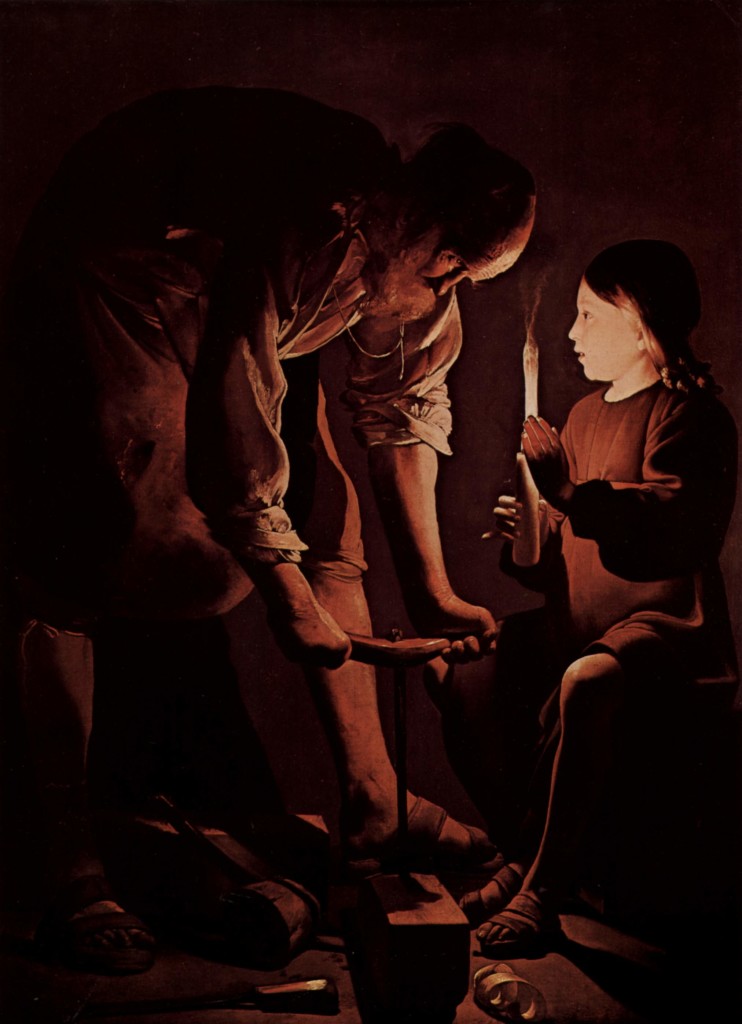Glorious St. Joseph, model of all those who are devoted to labor, obtain for me the grace to work in a spirit of penance for the expiation of my many sins; to work conscientiously, putting the call of duty above my inclinations; to work with gratitude and joy, considering it an honor to employ and develop, by means of labor, the gifts received from God; to work with order, peace, moderation and patience, without ever recoiling before weariness or difficulties; to work, above all, with purity of intention, and with detachment from self, having always death before my eyes and the account which I must render of time lost, of talents wasted, of good omitted, of vain complacency in success, so fatal to the work of God. All for Jesus, all for Mary, all after your example, O Patriarch Joseph. Such shall be my watchword in life and in death.

Georges de La Tour (1593-1652)
A fascinating painting of St Joseph with Jesus as a child. Art historians comment upon the play of light and darkness within the painting. The overall darkness of the background representing the condition of death at the time of Jesus as a child. The drilling of the hole into a wooden plank representing the crucifixion to come–the New Covenant established. The predominate color tone, a dirty earthy brown signifying the realm of matter, time and space. Shining, the presence of two lights. The candle (secular) held by Jesus illuminating his father’s work, and the divine inner light illuminating the child Jesus’ face. I find the image calming, delighting in the fascination of Jesus’ eyes as he witnesses his father. The son within the Trinity is awestruck by his humanly father. The immense love of the son for his earthly father tangible in observing. Working, St Joseph stares upon his son.
I like the discipline of observing artwork, the same for music, in regards to furthering my love and understanding of God. Aside from reasoning, aside from linear wordy concepts induced through reading, an immersion within an image allows a subtler approach to reality to form itself. I enjoy spending lengthy contemplative time observing a painting that captures. Imagine all the time the artist put into creating the work. The time of a skilled master merits worthy attention. His thoughts, abilities, and being tasted and appreciated. Meditative observing allows truths to settle subtlety. Proper reception of the painting is important in that we are not occupied with useless thoughts, wasting energy. Am I arrogant in my faith forcing me to doubt the authenticity of others? Can I marvel at the genius of others, understanding, all goodness comes from God? Do I trust in God so that my faith, hope, and charity is open and willing to His delicate interplay with others? Do I trust in the Church in regards to guiding me to appropriate works of creativity, and within creativity away from Catholicism am I respectful and prayerful, searching for God in all things, or am I judgmental, righteous, absolutely occupied with the need to dominate and be right? Have I expanded beyond the childish mentality of seeing myself within everything I encounter? Am I so absorbed in my own world and concerns that I cannot take my thoughts away from my preoccupations for an enriching experience? The rich interior life of an artist is an amazing place to perceive, a simulation of a deep prayer life, the secular combined with the divine. In perception maybe I am wrong. It is not so important. Trust in God, muse, repose, exercising faith hope and charity. I have heard it said: Don’t be so concerned about the facts, concentrate upon truth.

